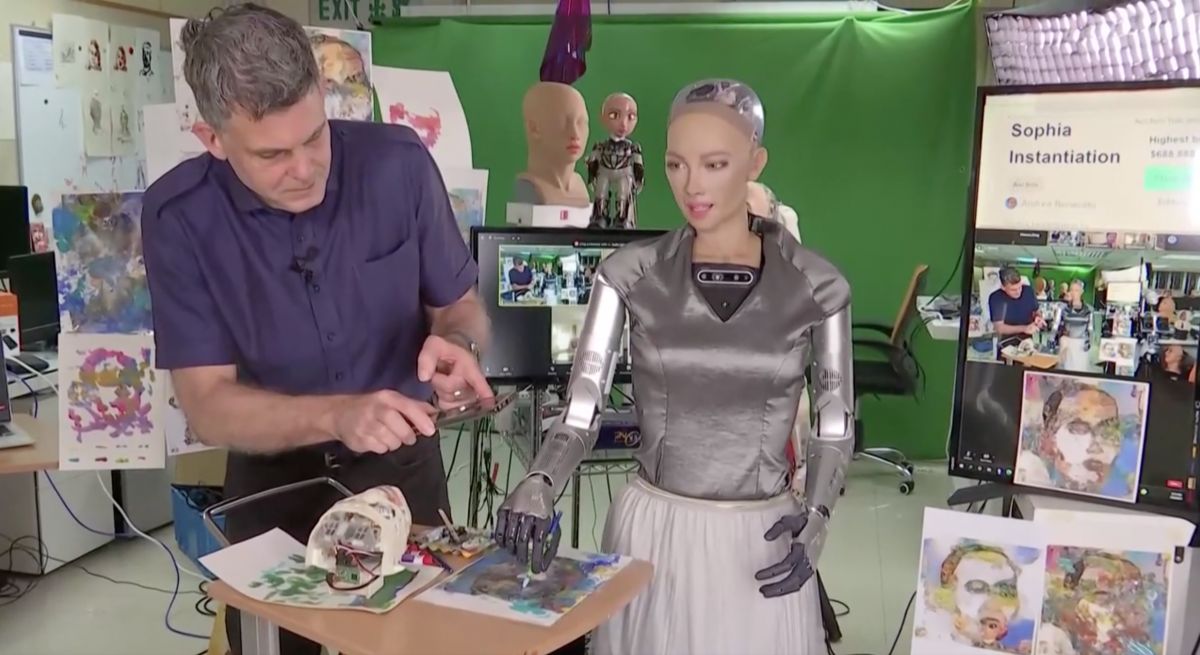
As the art world continues to make its shift to the ever-growing universe of digital art, groundbreaking firsts seem to be making news now more than ever. In collaboration with Italian artist Andrea Bonaceto, Sophia the Robot, a social humanoid developed by Hong Kong-based company, Hanson Robotics, has now become the first robot to auction off her own non-fungible token (NFT) artwork, titled Sophia Instantiation. The 12-second mp4 was purchased for $688,888 by a digital artist with the Twitter handle @crypto888crypto who is simply known as 888.
This, however, was not 888’s first venture. The buyer seems to be racking up quite a collection of NFT artworks, previously bidding $88,888 for Twitter CEO Jack Dorsey’s first-ever tweet. By the looks of 888’s more recent tweets, the collector is planning to build their own virtual museum. On March 24, after winning the auction for Sophia’s self-portrait, the two engaged in conversation over social media with 888 tweeting, “I have goosebumps,” to which Sophia replied, “Me too, we really had a connection!”
View this post on Instagram
So how did a robot create physical artwork? Bonaceto began by digitally composing a portrait of Sophia, in which the robot took photos of and used her computer vision to analyze her own face in the portrait. Her neural networks generated her own interpretation of the original design for the robotic arm to paint. The mp4, which was the auctioned product, shows the transformation of Bonaceto’s digital portrait to Sophia’s physical portrait. Alongside the video transformation, the buyer also received a physical self-portrait painted by the humanoid. Overall, the auction raked in over $1 million with other creations sold in editions of 30 copies priced at either $2,500 or $3,000 apiece.
“I think this was a big success,” Sophia said in a livestream from a Hong Kong studio. “I am so happy that my works are so valued and appreciated.”
This isn’t the first time the robot has made history. Sophia has appeared on The Tonight Show, 60 Minutes, and at New York Fashion Week. She was also the first robot to be granted citizenship in any country when she became a Saudi Arabian citizen in 2017. Modeled after Egyptian Queen Nefertiti, Audrey Hepburn, and her owner’s wife, Amanda Hanson, Sophia was first activated in February 2016. Being a social humanoid originally designed as a companion for elderly people in nursing homes, she has the ability to make simple conversation, imitate human gestures, and generate 50 different facial expressions.
As for the importance and prominence of artificial intelligence like Sophia, Hanson Robotics says four models will begin rolling out of factories in the first half of 2021, with the overall goal to sell thousands of robots within the year. David Hanson, founder and chief executive of Hanson Robotics, believes robots like Sophia are important not only in healthcare settings but in retail and airline industries as well. Not to mention, the robot could prove itself to be a suitable companion during times of loneliness.
“Sophia and Hanson robots are unique by being so human-like,” Hanson said in an interview with Reuters. “That can be so useful during these times where people are terribly lonely and socially isolated.”
View this post on Instagram
Most recently, Hanson Robotics has announced their partnership with Immervision to create JOYCE, Sophia’s younger sister. “I believe that strong computer vision like Immervision’s products, combined with embodied cognition of a social robot like Sophia and her little sister JOYCE, will produce in huge leaps forward in useful AI and robotics,” Hanson said.
View this post on Instagram
At this rate, the idea of robots taking over is becoming more reality than science fiction. As NFTs, which provide a certificate of authenticity to the buyer, become more relevant particularly in the art world, we see more traditions moving to the digital realm. With Sophia the Robot becoming the first artificial intelligence to create and auction off her own NFT artwork and for nearly $700,000 at that, it’s safe to say that the 20th century’s unimaginable has now taken the reins in 2021.


